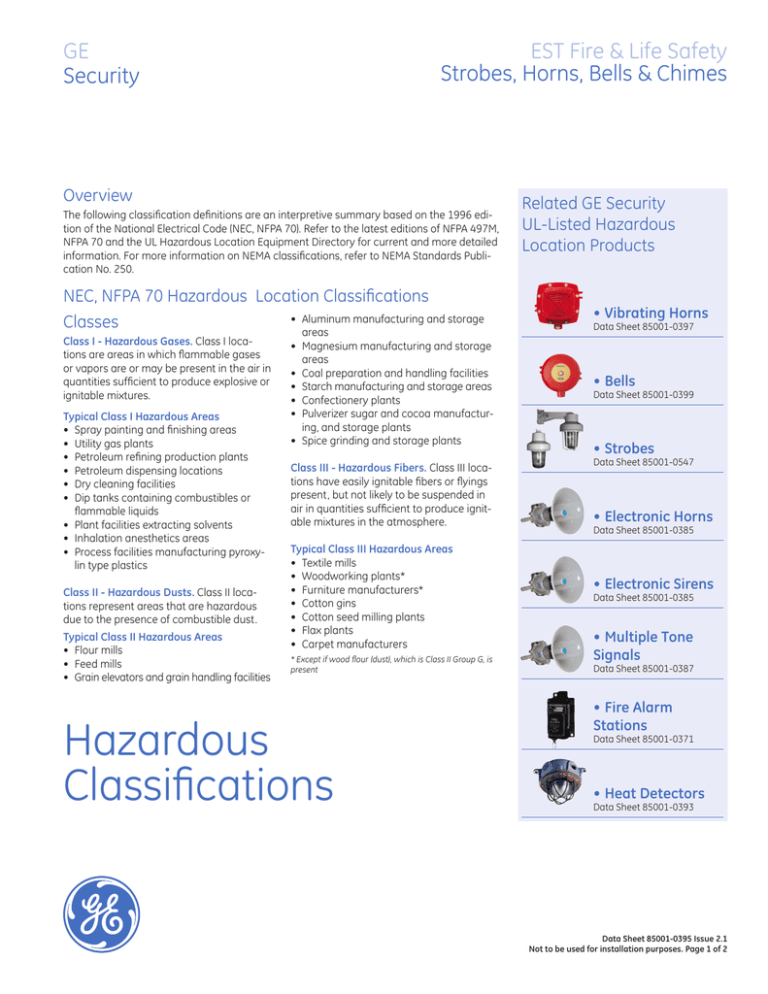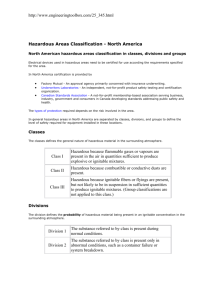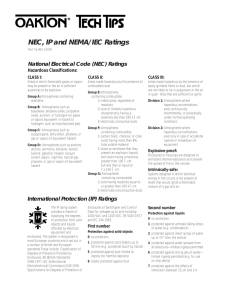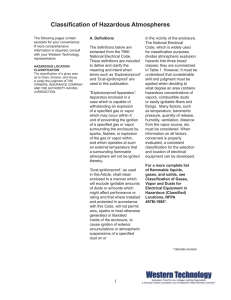
GE
Security
EST Fire & Life Safety
Strobes, Horns, Bells & Chimes
Overview
The following classification definitions are an interpretive summary based on the 1996 edition of the National Electrical Code (NEC, NFPA 70). Refer to the latest editions of NFPA 497M,
NFPA 70 and the UL Hazardous Location Equipment Directory for current and more detailed
information. For more information on NEMA classifications, refer to NEMA Standards Publication No. 250.
NEC, NFPA 70 Hazardous Location Classifications
• Aluminum manufacturing and storage
Classes
areas
Class I - Hazardous Gases. Class I locations are areas in which flammable gases
or vapors are or may be present in the air in
quantities sufficient to produce explosive or
ignitable mixtures.
Typical Class I Hazardous Areas
• Spray painting and finishing areas
• Utility gas plants
• Petroleum refining production plants
• Petroleum dispensing locations
• Dry cleaning facilities
• Dip tanks containing combustibles or
flammable liquids
• Plant facilities extracting solvents
• Inhalation anesthetics areas
• Process facilities manufacturing pyroxylin type plastics
Class II - Hazardous Dusts. Class II locations represent areas that are hazardous
due to the presence of combustible dust.
Typical Class II Hazardous Areas
• Flour mills
• Feed mills
• Grain elevators and grain handling facilities
• Magnesium manufacturing and storage
areas
• Coal preparation and handling facilities
• Starch manufacturing and storage areas
• Confectionery plants
• Pulverizer sugar and cocoa manufacturing, and storage plants
• Spice grinding and storage plants
Class III - Hazardous Fibers. Class III locations have easily ignitable fibers or flyings
present, but not likely to be suspended in
air in quantities sufficient to produce ignitable mixtures in the atmosphere.
Typical Class III Hazardous Areas
• Textile mills
• Woodworking plants*
• Furniture manufacturers*
• Cotton gins
• Cotton seed milling plants
• Flax plants
• Carpet manufacturers
* Except if wood flour (dust), which is Class II Group G, is
present
Hazardous
Classifications
Related GE Security
UL-Listed Hazardous
Location Products
•Vibrating Horns
Data Sheet 85001-0397
•Bells
Data Sheet 85001-0399
•Strobes
Data Sheet 85001-0547
•Electronic Horns
Data Sheet 85001-0385
•Electronic Sirens
Data Sheet 85001-0385
•Multiple Tone
Signals
Data Sheet 85001-0387
•Fire Alarm
Stations
Data Sheet 85001-0371
•Heat Detectors
Data Sheet 85001-0393
Data Sheet 85001-0395 Issue 2.1
Not to be used for installation purposes. Page of 2
GE
Security
U.S.
T 888-378-2329
F 866-503-3996
Canada
T 519 376 2430
F 519 376 7258
Asia
T 852 2907 8108
F 852 2142 5063
Australia
T 61 3 9259 4700
F 61 3 9259 4799
Europe
T 32 2 725 11 20
F 32 2 721 86 13
Latin America
T 305 593 4301
F 305 593 4300
www.gesecurity.com/est
© 2006 General Electric Company
All Rights Reserved
Divisions
Class II Groups
The Location Classes are broken down by
the NFPA into Divisions 1 and 2, defining
different levels of risk. In general, the risk of
there being a hazardous presence of flammable/combustible/ignitable materials is
higher for Division 1 than for Division 2. The
specifics differ between the three classes (I,
II and III). Equipment suitable for Division 1
is also suitable for Division 2 locations.
Group E. Atmospheres containing combustible metal dusts, including aluminum,
magnesium, and their commercial alloys,
or other combustible dusts whose particle
size, abrasiveness and conductivity present similar hazards in the use of electrical
equipment.
Groups
Class I and II locations are divided by the
NFPA into Group designations identifying
specific gases, vapors and dusts by characteristic similarities that relate to specific
equipment construction requirements.
Class III locations are not divided into separate group designations.
Class I Groups
Group A. Atmospheres containing acetylene.
Group B. Atmospheres containing hydrogen, fuel and combustible process gases
containing more than 30 percent hydrogen
by volume, or gases or vapors of equivalent
hazard such as butadiene, ethylene oxide,
propylene oxide, and acrolein.
Group F. Atmospheres containing combustible carbonaceous dusts, including carbon
black, charcoal, coal, or dusts that have
been sensitized by other materials so that
they present an explosion hazard.
Group G. Atmospheres containing combustible dusts not included in Group E or
F, including flour, grain, wood, plastic, and
chemicals.
NEMA Hazardous Location
Classifications
Type 7 Enclosures. Intended for indoor use
in locations classified as Class I, Groups A, B,
C, or D, as defined in the National Electrical
Code (see Class I Groups above)
Type 9 Enclosures. Intended for indoor use
in locations classified as Class II, Groups E,
F, or G, as defined in the National Electrical
Code (see Class II Groups above).
Group C. Atmospheres such as ethyl ether,
ethylene, or other gases or vapors of
equivalent hazard.
Group D. Atmospheres containing acetone,
ammonia, benzene, butane, cyclopropane, ethanol, gasoline, hexane, methanol,
methane, natural gas, naphtha (petroleum),
propane, or gases or vapors of equivalent
hazard.
Compiled with information provided by GE Security Signaling Products.
Data Sheet 85001-0395 Issue 2.1
Not to be used for installation purposes. Page of 2






